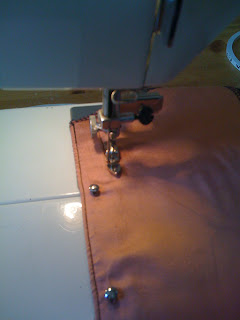Traditionally this is located on the back. howerver you can also place them anywhere you want.
(I made them with front closures when I costumed The Rocky Horror Show, specifically the floorshow corsets are gorgeous in my opinion)
The pieces we'll be working on are all pattern pieces of the centre back.
(2 outer layers, 2 lining, as in the picture below.)

The beginning is actually a lot similar to the busk insertion process.
First start by sewing the corresponding outer layers and lining together along the back seam.
(in most cases, along the straight lined edge of the fabric pieces)
The like before, press open en flat starting on the inside.
 After you have done this, you can fold the pieces and press them in the final position.
After you have done this, you can fold the pieces and press them in the final position.Do not press it exactly on the seam, but but press it a 1/8 inch (or 2mm) to the side of the seam. This will result in a small piece of the outer layer to turn to the inside of the garment.
(as in the picture below)

When you do this, you can be certain that no lining will show when laced up.
When you have done all this it is also important to trim the seam allowance like we did before.
(See my earlier post Inserting the busk 1 if you need more explanation)
Okay now like before, we need to sew a seam along the pressed border. Topstitch just 1/8 inch or 2 mm from the edge, as seen in the picture below.

Now it is time to start cutting a few pieces of boning. use flat steel boning for this type of closure.
Spiral steel boning is not advised for this.
I personally like to cut my bones, so they have enough room to slightly move up and down in the boning channel. If you cut them to long they will come tearing through the corset.
Use a pair of wire cutters (or anything that works) and cut the bones.
Don't try and cut them through at once, since this is impossible on a hand cutter.
Try to cut them a couple of times, and very gently try bending it on the place where you've made a cut. Don't use excessive force for this, cause to much bending will result in a curved ending to your bone, which is undesired. If it won't snap immediatly, try cutting it again.

Okay now that we've got the bones cut, it is important to create nice rounded edges to them.
This makes them easier to insert, makes for nicer wear, and protects the final corset from damage.
Either use a sanding stone, or if you don't have one, you can also cut the sharp corners off with the wire cutters and sand them down by hand.

Both my spiral and steel bones are 7 mm. this creates a nice and even effect.
Notice in the picture below, that I have place the bone under the sewing machine foot.
This is just so I can see that the left side of my foot matches up with the width of the bones.
You'll probably find something similar on most machines.
 Okay now it's time to start sewing our first boning channel. Don't start with the actual bone placed under your foot like the picture above. remove the bone and start sewing following the earlier made stitching.
Okay now it's time to start sewing our first boning channel. Don't start with the actual bone placed under your foot like the picture above. remove the bone and start sewing following the earlier made stitching.Once you've sewn one boning channel, test it's width by partially inserting one of the bones.
If it fits nice and snug continue sewing the other channel.
You should end up with something like the picture below.

Now we need to sew two more boning channels running parallel to the first.
However but since our eyelets are going to be placed in between these pieces of boning, we'll need to leave a space for them.
Now the eyelets I'm using on the corset are 4mm in diameter. I think you also call them size 0 in other countries.
Now the width of the space between the boning channels will depend on your eyelets and your personal taste. However don't make it to wide.
Once you've decided the placing of the second boning channel. start sewing.
You can take your last made seam as a gauge. however it is probably better to stick down a piece of tape on your machine at the desired distance, and simply follow that.
(See Cutting pattern pieces and preparing your machine)

After sewing the first seams you should have something that looks like this:
 Okay now sew the last seams and create the boning channels.
Okay now sew the last seams and create the boning channels. Insert the four pieces of boning.
Insert the four pieces of boning.
As in the picture below, the bones should sit nice and snug in their channels.
 For now we are finished with the back closure. Inserting the eyelets and the lacing will come at final end of assembly.
For now we are finished with the back closure. Inserting the eyelets and the lacing will come at final end of assembly.Let's se what we've achieved..

Beautifull.
Let's continue...






























